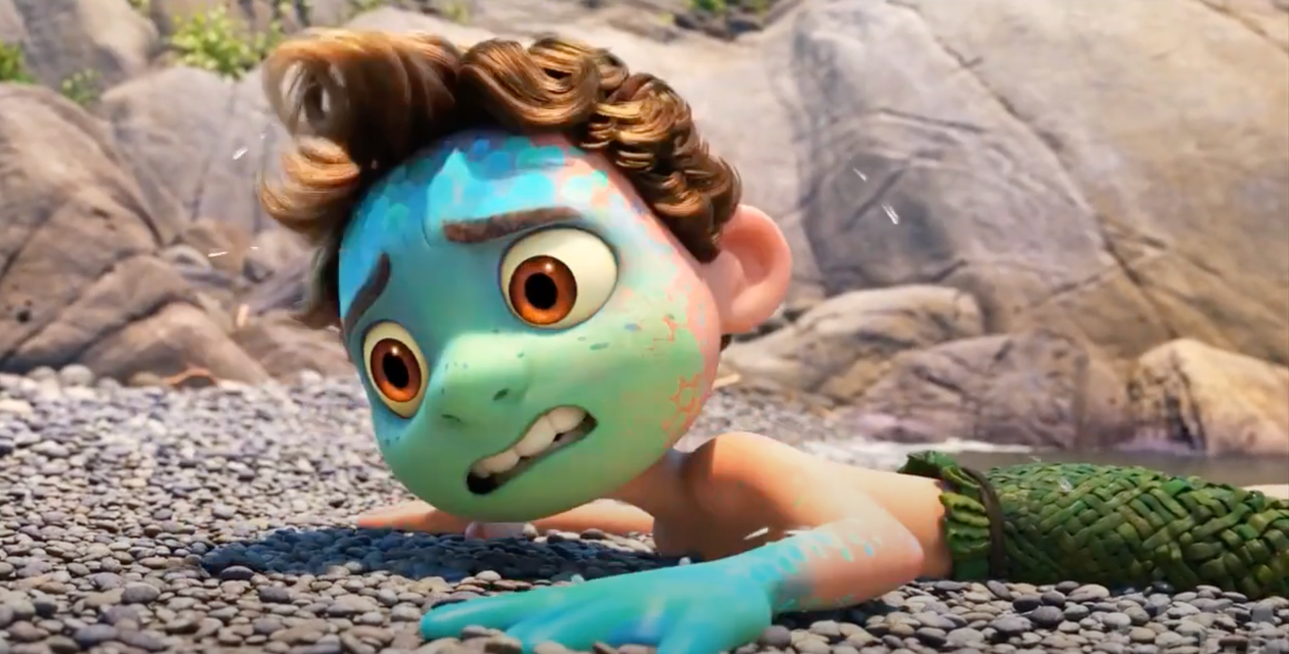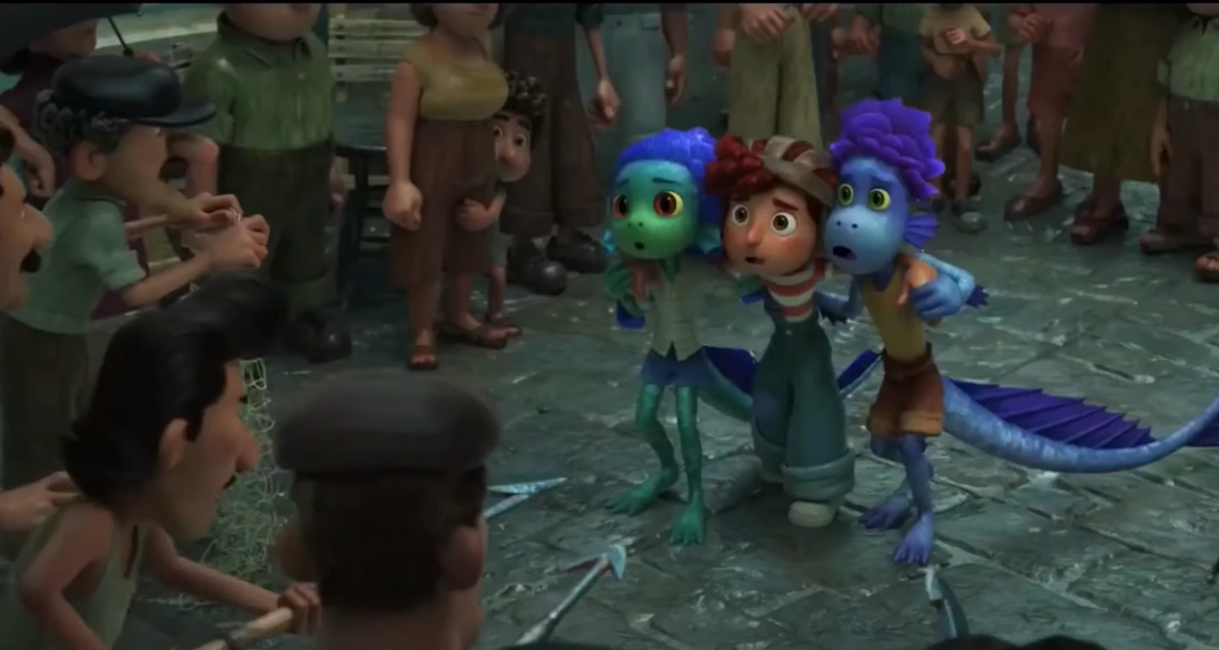“Silenzio, Bruno!” Where are the monsters lurking? An exploration of the Gothic in Disney and Pixar’s Luca
Under the sea, monsters lurk. Despite The Little Mermaid (Ron Clements & John Musker, 1989)’s Sebastian singing about under the sea being better, audiences have long held a fear of the ocean and what lies beneath. It is an understandable fear, linked to the fear of the unknown; after all, it is estimated that 80% of our oceans remain unexplored. Thanks to Hollywood, fear of what lurks in the ocean came to a head after the release of Spielberg’s Jaws in the summer of 1975 with the film scaring people out of the sea, and even decades on its legacy remains. It is in this context that the Disney and Pixar film Luca (Enrico Casarosa, 2021) was released in the summer of 2021, a film focused on two adolescent boys who are sea monsters but transform into humans on dry-land (Fig. 1) and must hide their sea monster identity in a seaside town steeped in Gothic tradition. Jeffrey Jerome Cohen, the pioneer of monster theory, proposed that the monster’s body is a cultural body, capturing the anxiety and desires of a particular moment in time (1996). As I argue in this blog post, Luca encapsulates the sense of dread that the ocean causes audiences, yet the majority of horror in the movie takes place on land, thus shattering the conventions of horror folklore. The Gothic has always been a staple of horror; defined by themes of internal and external conflict, and body transformations that challenge the normative status quo. Luca embodies these themes, but while the initial reaction to many inhabitants of this world is fear, the film seeks to breakdown the audience and character reactions of fear and challenge why we react with horror.
Luca is set in the fictional seaside town of Portorosso in Italy. Like many countries that aren’t landlocked, Italy has its own history of sea monsters in folklore. It was believed that sea monsters Scilla and Cariddi occupied the waters between Italy and Sicily – often causing havoc to the island and to passing ships. Luca’s director, Enrico Casarosa, even referred to the legends of fantastical sea monsters he encountered as a child as inspiration behind the film. He noted:
“There’s so many changelings in folklore … I love Japanese folklore – there’s the foxes that can (transform to) look like humans and the tanuki. There’s the selkies in Ireland. In Italy…there’s an old legend of Colapesce, about a boy who stays so much in the water, he becomes half fish.”
Luca and his fellow sea monster friend Alberto, spend much of the film hiding on land away from Luca’s anti-human sea monster parents, dreaming of owning a Vespa, and trying to avoid the wrath of locals who are terrified of sea monsters and react murderously whenever one is spotted. There is a particularly uncomfortable scene for Luca and Alberto when they visit their human friend Giulia’s house, and as her father prepares dinner, they watch on nervously as he butchers sea creatures for the meal. The swift brutality creates a lingering tension for the rest of the film, when it is inevitable that true natures are exposed in any Gothic story, as characterized by the classic ‘three’ Gothic tales of the creator Frankenstein reconciling with his own moral failings, the irrepressible amorality of Hyde, and the alarming discovery that one’s host may be a vampire. And this is a Gothic film, from the monstrous architecture to the desperate need to hide our true natures; the film is hinged on the edge of the collapse of social and familial borders.
Tension is woven throughout the computer-animated movie; Portrosso is littered with architecture depicting vicious sea monsters attacking unsuspecting humans. The seaside village’s buildings look frayed and from the 1800s, and there is the persistent theme of body horror prompted by the transformations that Alberto and Luca have little control over, automatically changing into humans when they are dry but as soon as the rain falls, they are exposed and (against their will) transform back into sea ‘monsters’ in plain sight of aggressive humans who threaten to kill any sea monster that inhabits the waters surrounding Portorosso. The first time Luca transforms from his latent monster state into a human boy, he reacts in horror. Transformations are a Gothic, fantasy and animation staple, and they often result in the belief that one form can embody evil, representing our hidden selves and private sins. Jack Halberstam insisted that a particular Gothic theme was to take two binary ideas: good and bad, health and disease, truth and lies, until the concepts began to collapse under the weight of their conflict so that they threaten the narrative’s foundations with ruin (1995, 2). This is most notable in Jekyll and Hyde, as Jekyll removes the characteristics he sees as grotesque and amoral into the transformed Hyde. Luca has failed to reconcile with himself, after years of hearing that humans are evil and that land is dangerous, his transformation that occurs the second he steps out of the sea is a visual representation of Luca breaking down cultural boundaries.
Luca’s internalised conflict also stems from his parents’ teaching, particularly his mother who forbids Luca from venturing on land (Fig. 2). When his parents chase after Luca to Portorosso, his mother assaults her husband once they both transform into humans, as she simply does not recognise her partner. Her self-loathing is shown through the animated violence directed towards her husband, used for comedic effect but nonetheless a scene that highlights the discomfort she feels within her own human identity. Not just fantastical sea monsters, they are also human – essentially hybrid monsters who are always in transition.
This self-conflict throughout Luca culminates into a war of words between the two boys: one comfortable with their sea monster status and resentful of humans, and one longing to forget their sea-monster identity. The monster’s body is a cultural body, but there is diaspora strife to a land that sea monsters are entitled to also call home, but still must overcome the policing of borders to access. Brave and reckless, Alberto dives into the sea and transforms in front of Guilia exposing the horror that even their new friend Giulia has toward sea monsters. Luca, in his panic, screams and points out the monstrous form of Alberto so that locals chase his best friend into the sea.
A fundamental component of Gothic fiction is the tension between the perceived monstrous and monstrous acts. For all of the fear about how Frankenstein’s creation looked – for not conforming to normative standards – the first monstrous act was committed by Frankenstein himself, when he created a new being and then abandoned it upon its creation in a society that would only ever see such a creature as a threat. Luca and Alberto look visually monstrous too; they do not conform to culturally-signaled and enforced standards of beauty, they have scales, they are blue and green evoking the deep sense of unknown from the ocean, and their hair looks like seaweed. Yet throughout the film they are the least disposed to violence. In one of the final scenes, Luca stands up to his tormentor Ercole Visconti (a rival in the Portorosso Cup who insults Luca, Alberto and Giulia repeatedly throughout the movie, taking the title of leading villain) after reclaiming his monstrous body in front of a crowd at Portorosso. Luca insists he is not afraid either of who he is, or what people say about him. With deliberate irony, Pixar features Ercole declaring that everyone is afraid of Luca and Alberto while brandishing harpoons in front of the young boys’ faces. Who is victimised? When Giulia’s father steps in to physically protect them and declare them the winners of the legendary Portorosso Cup there are cries that they aren’t “even people” - a maneuver to deny their personhood (Fig. 3).
The undercurrent of tension between humans and monsters builds an inescapable feeling of hopelessness and fragility throughout much of the film. Many scenes depict Luca’s dreams of escaping the societies he’s connected to. As residents of Portorosso warn of the fictional dangers of sea monsters, the real malevolence lurks within both Alberto and Luca. They struggle to control their mental ill-health from the unending attacks on their identities. Alberto devises a way to try and silence these internal doubts by commanding Luca to shout “silenzio, Bruno!” visualising the internalised voice of self-hatred as a man trying to repress their dreams, yet the disembodied voice, even when named evokes horror.
In the most Gothic-adhering scene of the film, the creeping threat of emotional collapse is directly acknowledged. In the dark of night, and in the aftermath of his bitter fight with Alberto, Luca travels to the isolated and uninhabited island to which his friend first took him, and when Luca was first horrified at the idea of transformation. He climbs dangerously up the ruins of a castle tower to try to find his emotionally and physically isolated friend who is essentially banished to this island, serving as a prison, after the revelation that Alberto is a sea monster. Alberto confesses that his father abandoned him, much like how Frankenstein banished his own creation, and Alberto has internalised this paternal rejection believing himself unlovable, pointing out Luca is “the good kid” while insisting he ruins everything. Duality was a particularly popular writing strategy in the 1800s Gothic period, pairing two concepts to contrast against one another, symbolising the deep and often conflicting extensions of ourselves that we cannot break from (Wasson 2010, 73). Alberto intends to expel Luca from his life so as not to be reminded of his own inferiority but, in a twist to Gothic tradition, Luca refuses and redefines their relationship to set positive boundaries. Their relationship is renewed by communication, sacrifice, and mutual respect, which resists the destructive tendencies of Gothic literature.
The film ends with sea monsters tentatively taking steps toward a life on land. Luca’s parents reveal their own nature after finally locating their son. Several elderly women who are pictured together throughout reveal that they too are sea monsters, their close relationship also hinting at another monstrosity that denies repressive norms; a hint at queerness by Disney, a corporation that still steadfastly refuses to depict queerness at the forefront of its works. The monsters that the audience and the residents of Portrosso needed to fear were ultimately not those lurking in the depths of the sea, but at the restrictive limits of their normative worlds that enforce borders and make this animated film a horror for the majority of its run time. Silenzio Bruno, and silenzio Ercole and all who would enforce cultural borders.
**Article published: February 25, 2022**
References
Brown, Tracy. 2021. ‘The story behind ‘Luca’s sea monsters and how they were brought to life’, The Spokesman, June 24, 2021. https://www.spokesman.com/stories/2021/jun/24/the-story-behind-lucas-sea-monsters-and-how-they-w/.
Cohen, Jeffrey Jerome. 1996. Monster Theory Reading Culture. Minnesota: Minnesota of University Press.
Halberstam, J. 1995. Skin Shows: Gothic Horror and the Technology of Monsters. Durham and London: Duke University Press.
Wasson, Sara. 2011. ‘‘A Butcher’s Shop where the Meat Still Moved’: Gothic Doubles, Organ Harvesting and Human Cloning.” In Gothic Science Fiction 1980-2010, edited by Sara Wasson and Emily Alder, 73-86. Liverpool: Liverpool University Press.
Biography
Stephanie Farnsworth is a PhD candidate at the University of Sunderland. Her research project focuses upon mutants in science fiction. Stephanie is also a co-founder of the academic network MultiPlay, which supports a multidisciplinary approach to game studies.







